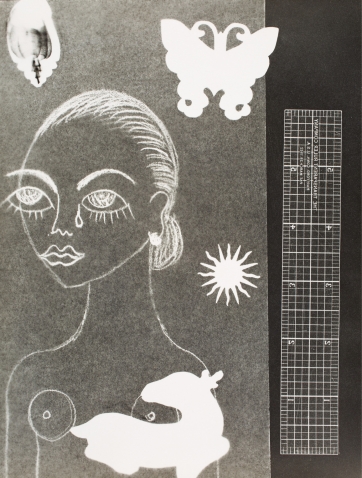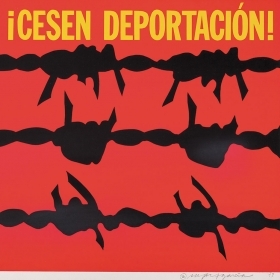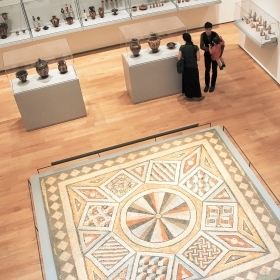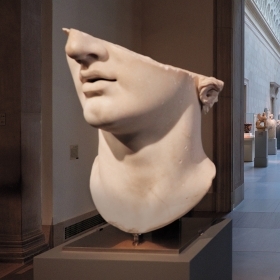Self-Portrait
Rosa Rolanda
Ca. 1930
Gelatin silver print photogram
8 ½ in. x 6 ½ in. (21.6 cm x 16.5 cm)
Davis Museum
Rosa Rolanda (1895–1970) was the mistress of re-invention. A native Californian, she became a celebrated dancer and performer in New York City and also a painter and photographer in Mexico City. She possessed not only smoldering good looks but also exquisite timing: During the Roaring ’20s, she toured Paris with the Ziegfeld Follies and met and was photographed (most notably in flamenco costume) by Man Ray (1895–1976).
Rolanda was born Rosemonde Cowan to parents with Scottish and Mexican roots. She was known by several names professionally, and after her marriage in 1930 to Mexican artist Miguel Covarrubias (1904–1957), she took his last name. She and Miguel moved in the modernist art circle that included Frida Kahlo, Diego Rivera, and Edward Weston, among many others.
The Davis Museum has acquired 40 photographs by Rolanda, part of the collection of Adriana Eller Williams ’55, a friend of the artist. A selection of these will be featured in the upcoming exhibition, Art_Latin_America, a survey of more than 150 works by 100 artists that opens at the museum this month.
“Rolanda was a leading creative figure in Mexico in the 1930s through the ’60s,” says James Oles, a specialist in Latin American art and senior lecturer in the art department who is curating the show. “It’s a coup for the Davis to acquire this group of photos that have been kept together for decades, which allows us to better understand her thought and work process.”
Rolanda was adept at the “photogram” technique, in which photographic prints are made by placing objects on photosensitive paper and exposing the arrangement to light, without the use of a camera. Man Ray was experimenting with the technique in the 1920s, making combinations of household objects into what one writer has called “tantalizing enigmas.” Photograms became popular with the Surrealists, who sought to unleash the power of the unconscious mind through nontraditional art techniques and unusual juxtapositions of imagery.
It’s not clear if Rolanda learned about photograms from Man Ray or from another artist friend. Several of her photograms, like the one pictured here, combine self-portraiture with objects from around her house: a jade deer from China, a silver butterfly pin, a cut seashell, and a 6-inch plastic ruler. Oles speculates that the large tear falling from her eye may be a nod to a 1924 Edward Weston portrait of his lover, the Italian photographer Tina Modotti. Tears also feature prominently in the self-portraits of Frida Kahlo. As Oles points out, both Rolanda and Kahlo knew well the experience of being women artists living under the shadow of their more-famous husbands.








We ask that those who engage in Wellesley magazine's online community act with honesty, integrity, and respect. (Remember the honor code, alums?) We reserve the right to remove comments by impersonators or comments that are not civil and relevant to the subject at hand. By posting here, you are permitting Wellesley magazine to edit and republish your comment in all media. Please remember that all posts are public.